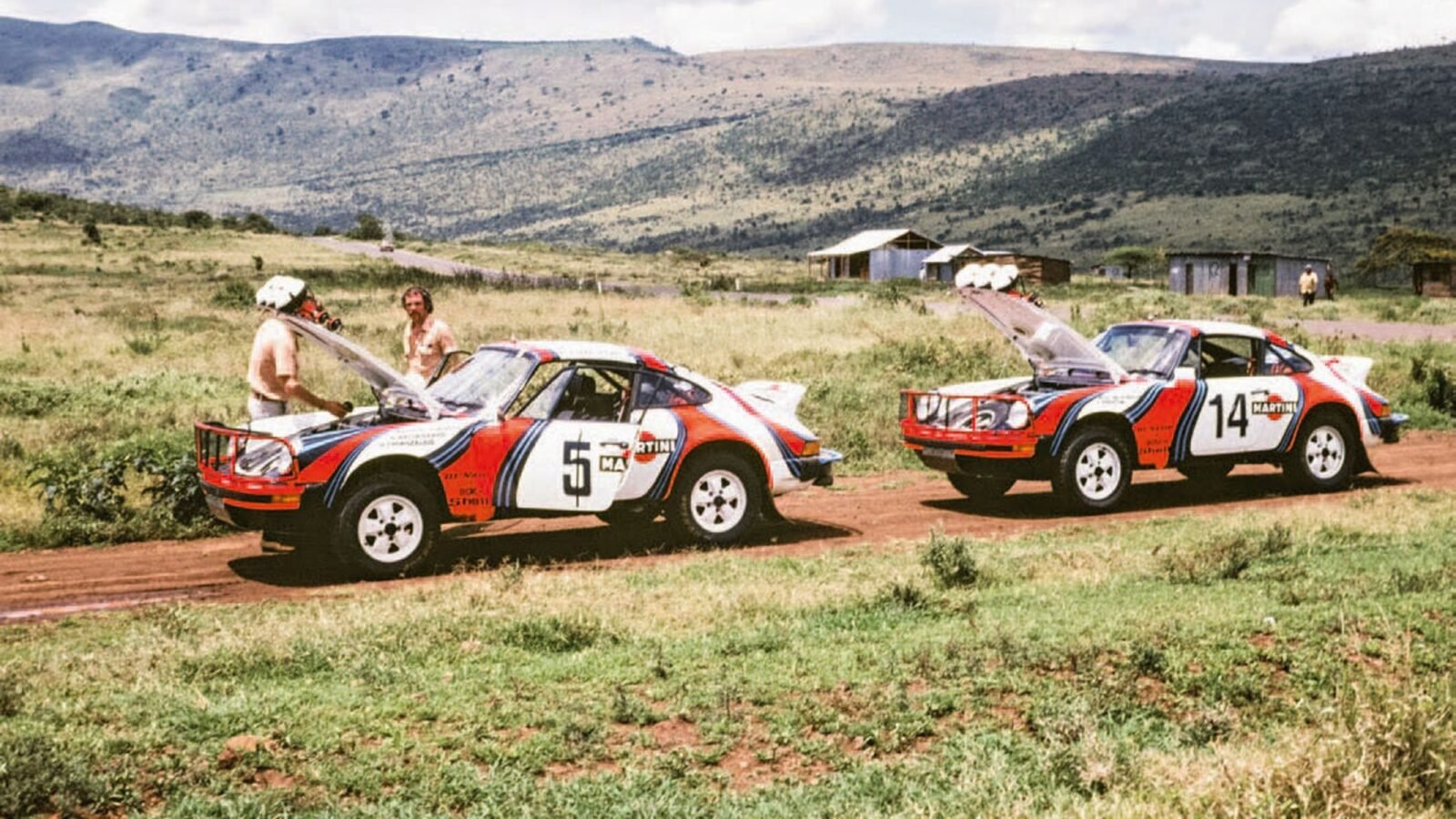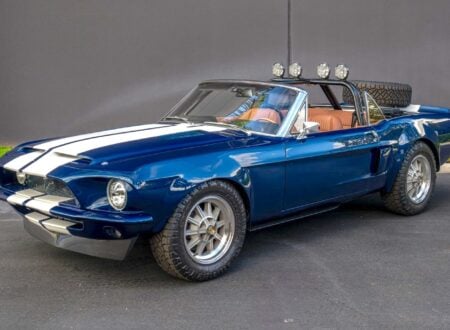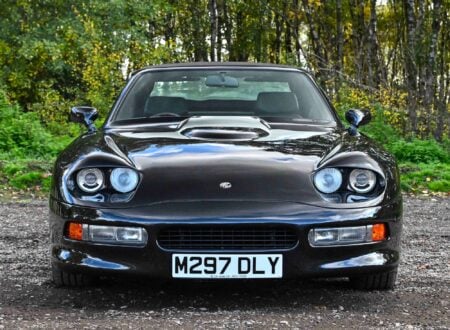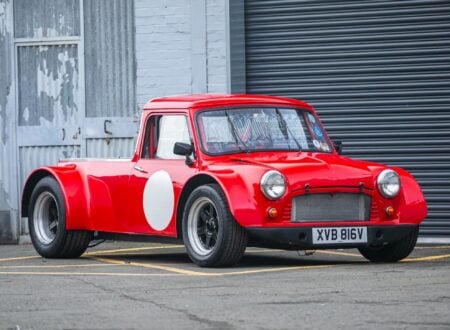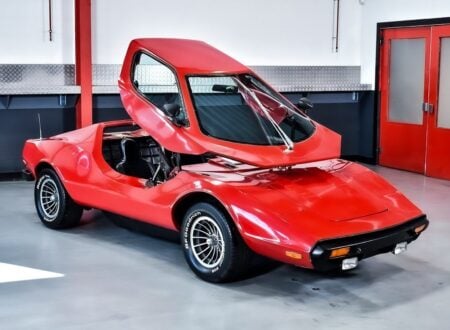The Martini racing livery was birthed in the psychedelic 1970’s when Martini turned an otherwise rather conservative Porsche 917 LH (Lang Heck – i.e. Long Version) race car into the “Hippie Car”, which then went on to take second place in the 1970 24 Hours Le Mans.
Then the designers took that “Hippie Car” idea and gave it organization into the Martini & Rossi corporate colors with flowing stripes that cleverly accentuated the lines of the car. This livery inspiration has stood the test of time and the Martini livery is always fresh, and yet always familiar.
Fast Facts – The Martini Racing Livery
- The Martini motorsport livery was inspired by their “Hippie Car” livery created by Porsche designer Anatole Lapine that made the 1970 Martini Porsche 917 LH instantly recognizable as it whirled around the Le Sarthe race track to take second place in the 1970 24 Hours Le Mans.
- The following year, 1971, the livery design was completely revamped and successfully combined the Martini & Rossi colors with almost psychedelic stripes into a livery that made the car look as if it was going fast even when it was standing still.
- This use of stripes that flow with the body lines of the car have enabled the livery to change and always look fresh, and yet always be familiar and instantly recognizable.
- The Martini livery has appeared on sports cars, rally cars, Formula One cars, and powerboats, and always looks completely at home whatever its on.
The Origins Of The Martini Racing Livery
The Martini cocktail, made by mixing either vodka or gin with Italian Martini vermouth and then plopping an olive into it, was made famous by a British ex-spy named Ian Fleming who wrote a series of spy thriller books about “James Bond 007” in the post World War II years beginning with Casino Royale in 1953.
Bond’s cocktail of choice was a Vodka Martini. A martini can be made with either gin, which is rather British and evocative of the Empire and stuffy British colonialists sipping gin and tonic, or it can be made with Vodka, which is Russian and evocative of a mysterious, dark and dangerous Eastern Europe.
So it was perfectly appropriate for Fleming’s spy, James Bond, to choose the Vodka Martini, with its Russia connection, setting him apart as a man of exotic tastes doing a dark and dangerous job.
The Martini became famous through the books, and then even more famous when the movies started appearing, beginning with Dr. No in 1962, From Russia With Love in 1963, and Goldfinger in 1964. So we can assume that sales of Martini & Rossi Vermouth were strong and the company’s public profile was somewhat enhanced.
Vermouth makers Martini & Rossi were located in the Italian city of Turin, and the story of how this maker of a cocktail ingredient came to be a major sponsor of motor sport began with a man named Paul Goppert, who was in charge of publicity and public relations for Martini Germany.
Paul Goppert decided to make a fledgling foray into top level motorsport and got together with two established racing drivers; Paul Richards and Charlie Kolb, and prepared two Alfa Romeo Giulietta SZ Coda Troncas to campaign in the 3 Hours Daytona in 1962, which was the same year the first James Bond movie, Dr. No, made its premiere.
Of special significance at this point was not the livery of the cars, they were painted red, but the fact that the front wings/fenders of each car had “Martini & Rossi Racing Team” emblazoned on them in white lettering. Martini & Rossi were making their first foray into top level motorsport endurance racing. They made their humble beginning in the 3 Hours Daytona of 1962 and gained promising results with Charlie Kolb winning the GT1.3 class and Paul Richards finishing in second place in that class.
Paul Goppert had a close friend named Hans-Dieter Dechent who was an Opel dealer in Saarbrücken, Germany. Dechent was a keen racing driver who’s penchant was for long distance endurance racing and Porsche racing cars.
When the rules were relaxed to allow cars to be decorated with advertising not related to motor sport in 1968, Goppert and Dechent put Martini & Rossi stickers on the Scuderia Lufthansa Porsche 910 race cars that Dechent was campaigning and that small beginning would lead to far more ambitious automotive art work.
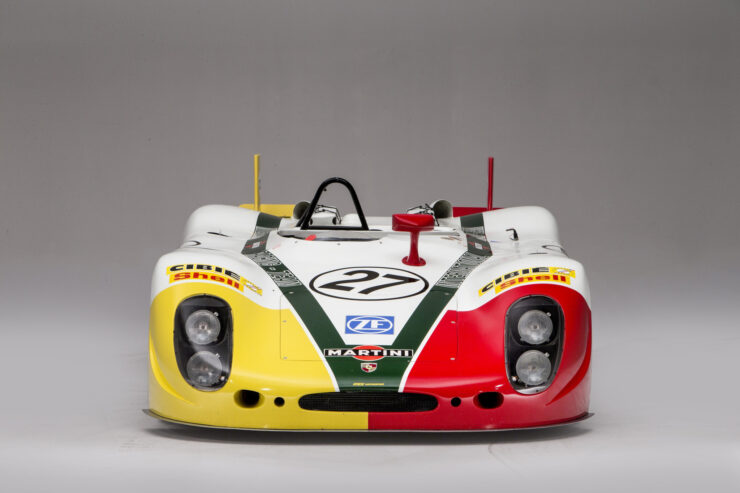

The late 1960’s and 1970’s were the era of flared trousers, platform soled shoes, and psychedelic paintwork which was, I think, calculated to give the visual impression of being dosed on LSD even when you weren’t. American singer Janis Joplin owned a Porsche 356 which she had painted in a psychedelic livery, and John Lennon of The Beatles had his Rolls-Royce done in a psychedelic livery also.
So if ever a psychedelic livery was to make its debut on a racing car then the 1970’s was without doubt when that would happen – and happen it did.
For the 1970 racing season the Martini & Rossi International racing team was formed by Goppert and Dechent. They began campaigning using two 3 litre Porsche 908/02 “Flunder” racing cars with Dechent as one of the drivers: these cars being ex-Porsche works team cars. But things were about to become more interesting when Ferdinand Piech, the grandson of Ferdinand Porsche, and engineer at the factory, offered the Martini and Rossi International team the opportunity to campaign the new 4.5 litre Porsche 917.
Hans-Dieter Dechent appreciated what this would mean for the team and decided to undertake the management/leadership of the team, and to get the best possible drivers and support crew to get the best results possible.
Dechent had a penchant for a unique and eye-catching psychedelic livery on his Porsche 917 LH (Lang Heck – i.e. Long Version) race car and he got the input of Porsche designer Anatole Lapine to create a very 1970’s art livery which featured purple with matt flourescent green swirling lines, it looked like a car Jimmi Hendrix would have loved: in fact it seemed to trace in paint the sort of musical sounds Hendrix traced with his guitar. To get an idea of this try listening to Hendrix rendition of the United States anthem, “The Star Spangled Banner”, which he played at the Woodstock music festival in 1969.
This livery made it perhaps the most admired racing Porsche ever to grace a race track. It appeared at the 1970 24 Hours Le Mans and obtained second place driven by Gerard Larrousse and Willibert ‘Willi’ Kauhsen.
Not only that but it earned itself the nickname the “Hippie Car”, and it certainly got the Martini & Rossi International racing team noticed, the livery helped make the car an instant motorsport icon.
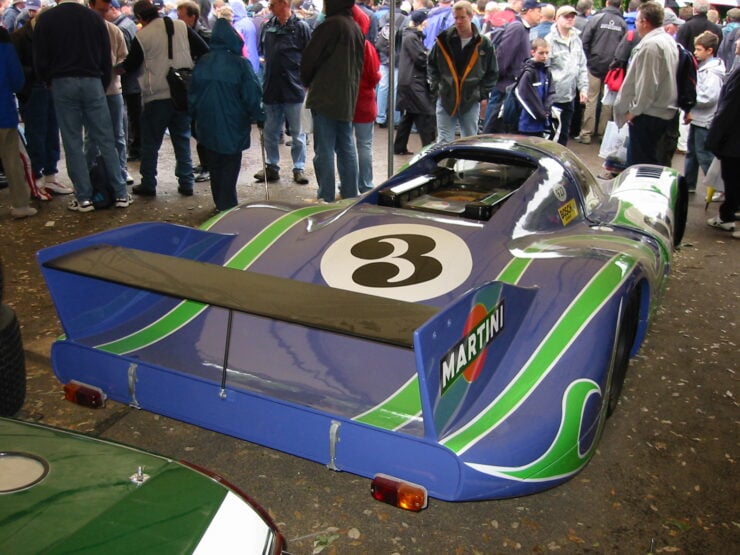

This car was under Martini & Rossi sponsorship and while it came second in the race results it was certainly the winner of the livery contest. The race winner that year was a works Porsche 917 K driven by Hans Herrmann and Richard Attwood which was painted in a red livery with white stripes – although they do seem to have proved the theory that “red cars go faster”.
1971 would see the birth of what is generally recognized as the classic Martini Racing livery. The new livery did not look like a piece of rolling artwork created while under the influence of a cocktail of LSD and “magic mushrooms”. This was a livery that was at once artistic, yet businesslike.
The Martini Racing livery was and is centered around the Martini logo, either a black or navy blue rectangle with the word “Martini” in white filling it. Behind that is a red circle about half the width of the lettering. From there is where things get interesting.
If you’ve ever driven a highway at high country road speeds and experienced the road lines racing towards you, then this is, I think, the inspiration for the livery that wraps around the car and forms the focal for the Martini logo. The Martini livery is based around stripes that wrap around the features of the car just like the fast moving road lines wrap into a driver’s vision as he/she flies along the highway.
Its the stripes that make a car decked out in the Martini Racing livery look as if its moving fast even when its parked.
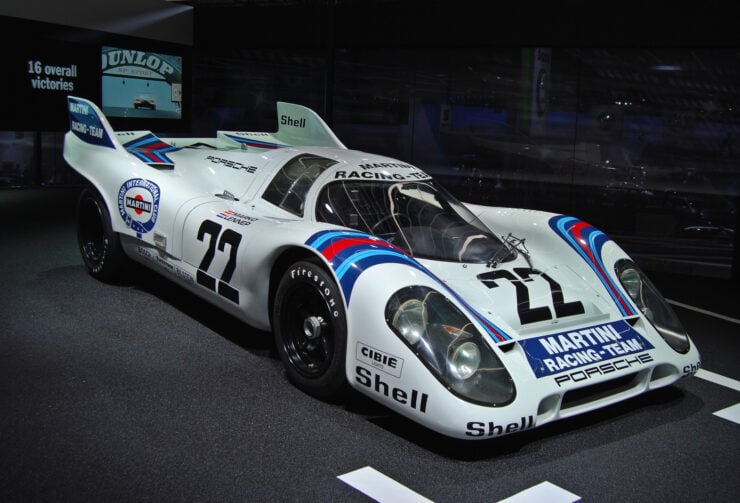

Starting out with a base color, either gray, white or blue, and with the Martini logo strategically placed, often on the front of the car and perhaps also the rear, a series of closely packed stripes is applied to accentuate the body lines of the car. These stripes are typically dark blue, red, and light blue, and they swirl across the car as if they were applied by its slip-stream.
There is a saying, “If it doesn’t catch your heart its not art”, and the Martini livery is one that without doubt catches one’s heart, captures one’s eye, and holds that attention.
This new livery made its Le Mans debut in 1971 and the Martini team won the race, and arguably the livery competition also.
In 1973 the Martini livery adorned Porsche 911 Carrera RSR race cars and these didn’t just look good, but took victory at the 24 Hours Daytona and the Targa Florio, adding the spice of competition success to the eye-catching paintwork.
1976 saw a Martini Porsche 936 win at the 24 Hours Le Mans, a feat which was repeated the following year.
The Martini livery was not solely relegated to race cars at this point but found its way onto Porsche special edition models such as the Porsche 924 ‘Martini Championship Edition’ which was made between December 1976 until March 1977.
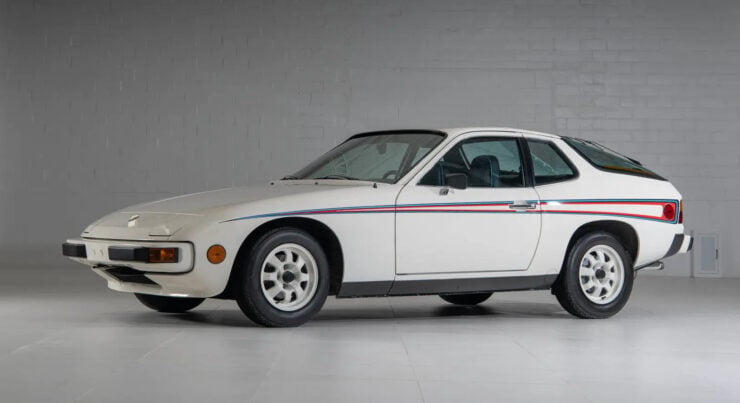

Rallying
For 1978 the Martini International Racing Team decided it was time for something completely different, and what could be more different than to go from motor-racing to motor-rallying, and not just any tame civilized rally but the rough and decidedly un-civilized East African Safari Rally which involved tearing across the landscape of the “Dark Continent” with howling engines, retina burning lights and speed sufficient to make the most courageous lion run for cover.
The Martini weapons of choice for the East Africa Rally were two modified Porsche 911SC. These cars were given a bit more than the standard rallying hardening up treatment and had raised suspension and a decent roll cage to keep the crew alive and unscathed in case of a wheels-up excursion into the bush.
The livery was predominantly white with dark blue, red and light blue semi-psychedelic stripes forming a swirling pattern that looked a bit as if the car had been driven through a series of paint puddles: swirling but neat.
One car was driven by Björn Waldegård and Hans Thorszelius and they managed to emerge from the rally in second place while the second car driven by Vic Preston Junior and John Lyall took fourth place honors.
Suffice to say Porsche happily made Special Edition production cars to commemorate their rallying victories.
Although Martini had primarily sponsored teams using Porsche road rockets by 1979 they had decided to widen their influence and began to sponsor Italian and other motorsport efforts. These efforts included a Ferrari 308 FTB in Group 4, but most significant was Martini’s pairing up with Lancia, who were also headquartered in Turin, with a view to going rallying with their Lancia Beta Montecarlo Turbo Group 5 cars, and to get into endurance sports car racing with Lancia’s open cockpit LC1 and LC2 sports cars built around a tubular frame designed by Dallara.
These cars all wore the Martini livery in various iterations of flowing stripes combining the dark blue, light blue and red.
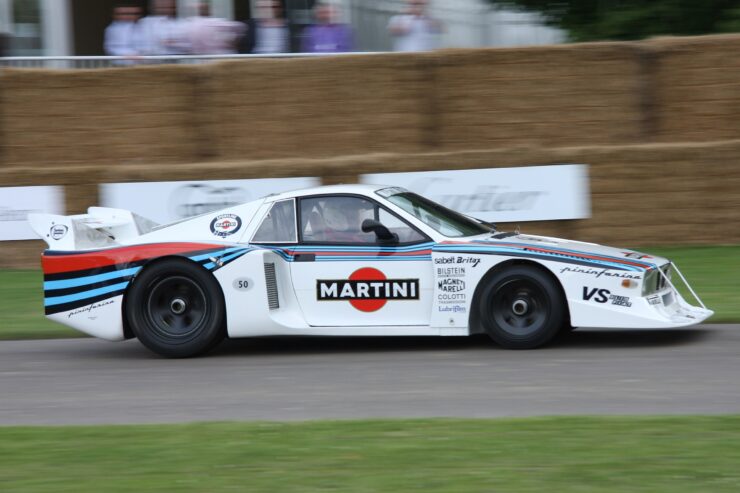

It would be in 1982 that Martini would enter into sponsorship of Lancia’s team in the World Rally Championship Group B. The car was the Lancia 037 and this sponsorship would continue through to the end of the 1992 season.
The Martini Lancia Team would win the World Rally Championship Driver’s title in 1987,1988, 1989, and 1991, and the Constructors title in 1983. The livery was a white background with the classic Martini stripes and logo.
Although the Martini Lancia 037 Group B car might be the most famous of the Martini liveried rally cars it was the Lancia Delta HF Integrale that took home the most titles.
Formula One
After a tentative first foray into the ethereal world of Formula One racing in 1972 Martini got into partnership with the Brabham team in 1975 campaigning the BT44B packing a Cosworth engine. This car being in a white livery with Martini stripes. For 1976 the car was Alfa Romeo powered and the livery was red with Martini stripes and logo.
Martini did not achieve competition success in Formula One and moved to sponsor Lotus in 1979. The livery of these cars was Lotus green with the Martini logo and stripes in the usual dark blue, light blue and red.
It would not be until 2006 that Martini would have another tentative probe into Formula One with a sponsorship of Scuderia Ferrari, and then after that beginning in 2014 until 2018 with sponsorship of the Williams Team. The livery being the classic Martini stripes on a white or gray body color.
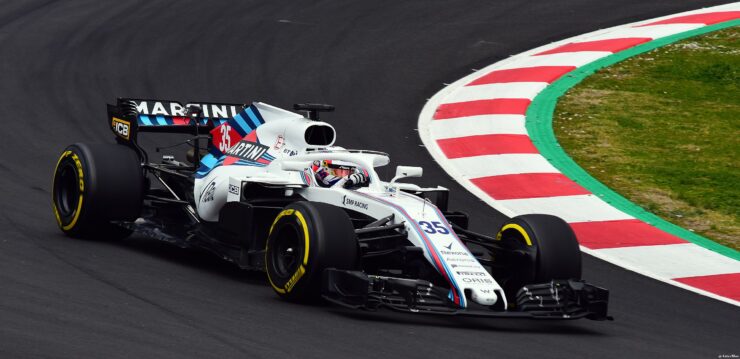

Power Boat Racing
Not content with just having their logo and livery adorning high profile motor sports Martini also ventured into the world of powerboat racing competition. They began in 1973 and then in 1975 sponsoring the boats of Carlo Bonomi and Cesare Fiorio, most famous of which is the “Cigarette”, fully decked out in classic Martini livery of white boat with the dark blue, red and light blue stripes.
Martini continued their involvement in off-shore powerboat racing through to 2014.
Conclusion
The Martini racing team livery has proved to be not only one of the most enduring, but also one of the most attention grabbing – yet it grabs one’s attention in the most tasteful and unpretentious way. This livery turns racing cars into rolling works of art, with just a hint of 1970’s style psychedelic style. It is possible to combine psychedelic paintwork into a professional livery and Martini’s designers have shown us that they figured out how to do it: and they do it beautifully.
Picture Credits: Feature image at the head of this post of Martini Team Porsche in the 1978 East Africa Safari Rally: picture courtesy Porsche. All other pictures as individually credited.

